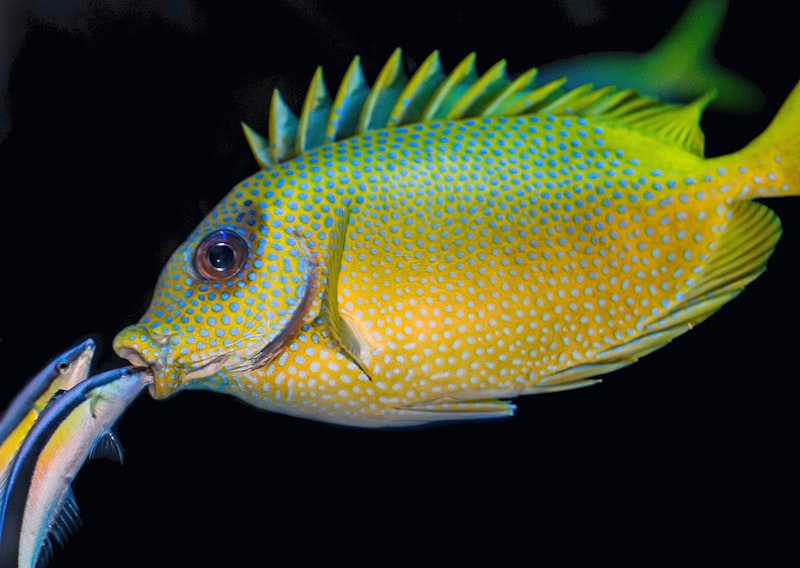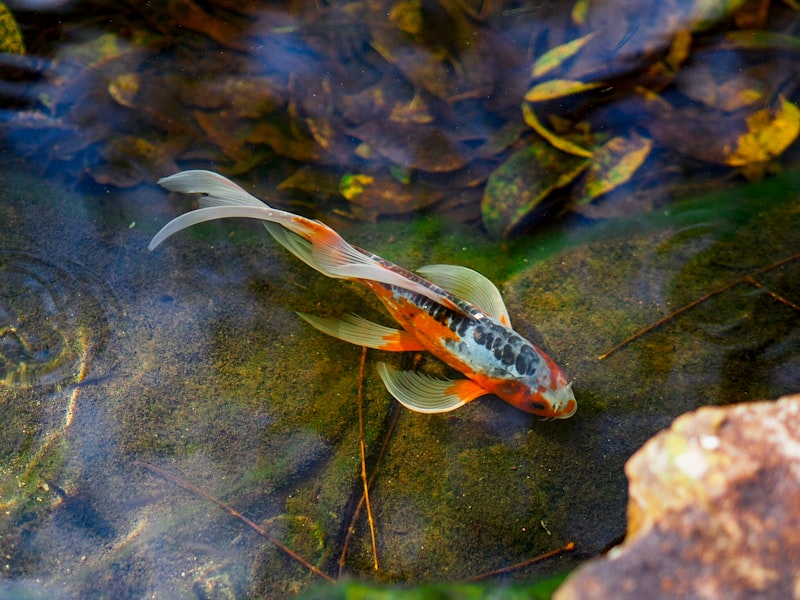From the moment of fertilization, mangrove fish embryos embark on a remarkable journey of development. Their eggs, often laid in sheltered areas among mangrove roots, face the challenge of surviving in brackish waters. Here, the balance between salt and freshwater is precarious, requiring these embryos to adapt quickly.
As embryos develop, they undergo a series of transformations. Initially, they rely on the yolk sac for nutrition, gradually developing structures like fins and gills essential for aquatic life. This stage is critical as it sets the foundation for their survival in mangrove habitats.
Metamorphosis marks a significant milestone in mangrove fish development. As larvae, these fish undergo profound changes in body shape and physiology to prepare for independent life outside the egg. They must quickly adapt to the mangrove’s unique conditions, where roots provide shelter and nutrients, and the tides govern their environment.
The developmental biology of mangrove fish showcases nature’s adaptive brilliance. Each stage, from egg to juvenile, is a testament to their evolutionary journey. Researchers study these processes to understand how these fish thrive amidst environmental challenges, offering insights into broader ecological principles and conservation strategies.
The developmental biology of mangrove fish is a captivating exploration of adaptation and survival in coastal ecosystems. By unraveling the intricacies of their growth, scientists deepen their understanding of marine biodiversity and the delicate balance of life in mangrove forests.
Unveiling Nature’s Strategy: How Mangrove Fish Adapt Developmentally
Mangrove forests are not just a tangle of roots and mud; they are intricate ecosystems teeming with life, including a remarkable variety of fish species uniquely adapted to thrive in this challenging environment. Among these species, mangrove fish stand out for their fascinating developmental adaptations that allow them to navigate the ever-changing conditions of their habitat.
One of the most striking features of mangrove fish is their ability to adapt physiologically and behaviorally to fluctuating salinity levels. Unlike many other fish species, mangrove fish can tolerate both freshwater and saltwater environments, thanks to specialized kidney functions that help regulate internal salt levels. This adaptation enables them to move freely between different zones within the mangrove forest, where water salinity can vary dramatically with the tides.

Another crucial adaptation seen in mangrove fish is their unique breeding strategies. Many species have evolved to lay their eggs in shallow, oxygen-rich waters among the mangrove roots. This behavior not only protects the eggs from predators but also ensures that the developing embryos have access to sufficient oxygen—a necessity in the often oxygen-deprived muddy waters of mangrove swamps.
Behaviorally, mangrove fish exhibit complex patterns of movement and feeding that are closely tied to the tidal cycles. During high tide, when water levels rise and cover the roots, these fish venture deeper into the forest to feed on insects, crustaceans, and detritus that become abundant in the submerged environment. As the tide recedes, they retreat to deeper pools or burrows in the mud to avoid predators and conserve moisture until the next high tide.
In essence, the adaptive strategies of mangrove fish highlight nature’s ingenious solutions to the challenges posed by the dynamic mangrove ecosystem. By studying these adaptations, scientists gain insights not only into the resilience of mangrove ecosystems but also into the broader principles of evolutionary biology and ecological resilience.
From Estuaries to Ocean: Exploring Mangrove Fish Development
Have you ever wondered how fish in mangrove forests navigate their journey from estuaries to the vast ocean? The journey of mangrove fish development is a fascinating tale of adaptation and survival. Mangroves, with their intricate root systems submerged in brackish waters, serve as crucial nurseries for a myriad of fish species. These environments provide abundant shelter and food, allowing young fish to grow and develop away from larger predators.
As juveniles, fish in mangrove ecosystems undergo significant physiological changes that prepare them for oceanic life. They adapt to varying salinity levels and develop specialized respiratory systems that enable them to thrive in both freshwater and saltwater conditions. This adaptation process is crucial as it equips them with the ability to navigate through different aquatic environments as they mature.
The transition from estuaries to the open ocean is pivotal in the life cycle of these fish. It marks a phase where they venture into deeper waters, encountering new challenges and opportunities. Some species use estuaries primarily as breeding grounds before their offspring embark on their journey to the sea. Others may utilize mangroves as a permanent habitat, finding sustenance and protection throughout their lives.
Researchers continue to study the intricate relationships between mangrove ecosystems and fish development. They explore how environmental factors such as water temperature, food availability, and habitat structure influence growth patterns and species diversity. Understanding these dynamics is essential for conservation efforts aimed at preserving mangrove forests and the biodiversity they support.
The journey of mangrove fish from estuaries to the ocean is a testament to nature’s resilience and adaptability. It underscores the interconnectedness of diverse habitats within our marine ecosystems, highlighting the importance of safeguarding these fragile environments for future generations.
This article captures the essence of mangrove fish development, emphasizing adaptation, survival strategies, and the ecological significance of mangrove ecosystems.
Survival Secrets: The Evolutionary Path of Mangrove Fish Development
Have you ever wondered how fish adapt to survive in the challenging environment of mangrove forests? The evolutionary journey of mangrove fish holds fascinating secrets of adaptation and resilience. These unique ecosystems, where land and sea intertwine, pose significant challenges that have shaped the evolution of fish species over millennia.
Mangrove forests are dynamic habitats, characterized by fluctuating water levels, varying salinity, and intricate root systems. Fish living here must navigate these complexities to thrive. One remarkable adaptation is seen in the respiratory systems of mangrove fish. Many species have evolved specialized organs that enable them to breathe air when oxygen levels in the water are low, a crucial adaptation for survival in oxygen-deprived tidal pools.
Another survival strategy involves reproductive adaptations. Some mangrove fish have developed unique breeding behaviors and strategies to ensure the survival of their offspring in such dynamic environments. For instance, certain species time their spawning to coincide with the tides, allowing their eggs and larvae to be carried away to safer, more oxygen-rich waters.
The relationship between mangrove fish and their environment goes beyond mere survival—it’s a testament to evolutionary innovation. These fish have adapted not only physically but also behaviorally. They exhibit complex social behaviors and feeding strategies that capitalize on the rich biodiversity found within mangrove ecosystems.
Furthermore, the symbiotic relationships formed between mangrove trees and fish highlight the interconnectedness of life in these habitats. Fish find refuge among the roots of mangrove trees, utilizing them as nurseries and safe havens from predators.
The evolutionary path of mangrove fish development is a story of resilience and adaptation. It showcases nature’s remarkable ability to thrive in seemingly inhospitable environments. As we continue to study these ecosystems, we uncover more about the intricate balance that sustains life in mangrove forests, offering insights into how organisms evolve to overcome challenges and thrive.
Environmental Influences on Growth: The Biology of Mangrove Fish
Mangrove forests are not just serene landscapes; they are bustling ecosystems where marine life thrives against unique environmental challenges. Among these inhabitants, mangrove fish stand out for their fascinating adaptation skills shaped by their surroundings. These fish navigate a delicate balance of salt and fresh water, thriving in the intertidal zones where mangroves grow. Understanding the environmental influences on their growth offers insights into their biology.
Mangrove fish are remarkably resilient to fluctuating salinity levels, a hallmark of their habitat. This adaptability allows them to exploit the diverse resources offered by mangrove roots and tidal waters. Their growth patterns are intricately linked to seasonal changes, where they capitalize on nutrient-rich detritus from decaying plant matter. This biological phenomenon not only sustains their population but also supports the broader mangrove ecosystem.
In these brackish waters, mangrove fish encounter a myriad of predators and prey. Their evolution has equipped them with unique camouflage and swift movements to evade danger and capture food efficiently. Such survival strategies underscore their role as both predators and prey in the complex food web of mangrove forests.
Furthermore, the structure of mangrove roots provides essential shelter for juvenile fish, shielding them from predators until they mature. This sanctuary fosters their growth and contributes significantly to the biodiversity of coastal waters. As key players in nutrient cycling, mangrove fish help maintain water quality and support the livelihoods of coastal communities dependent on fisheries.

The biology of mangrove fish exemplifies nature’s intricate design where environmental influences shape growth and survival strategies. By adapting to the dynamic interplay of saltwater and freshwater, these fish embody resilience and adaptation in the face of environmental challenges. Studying their biology not only enriches our understanding of coastal ecosystems but also underscores the importance of preserving mangrove habitats for future generations.
Adapting to Dual Worlds: Mangrove Fish Development Unraveled
Have you ever wondered how fish manage to thrive in such diverse habitats as mangroves? It’s a marvel of adaptation, where these aquatic creatures navigate between two distinct worlds: the salty ocean and the brackish waters of mangrove forests. This ability to adapt is crucial for their survival, offering them unique advantages in both environments.
Mangrove fish are remarkable for their ability to withstand varying salinity levels. Unlike ocean fish, which are adapted to high salinity, mangrove fish have evolved to thrive in waters where saltiness fluctuates. This adaptability is akin to having a versatile toolkit, allowing them to adjust their osmoregulation processes effortlessly.
One of the key adaptations of mangrove fish lies in their morphology. They possess specialized gills and kidneys that can regulate the intake and expulsion of salts, maintaining internal balance regardless of external conditions. This biological feat is akin to a finely tuned machine, constantly adjusting to the ebb and flow of the tides.
Moreover, mangrove fish exhibit unique behaviors that enhance their survival in these dual environments. They often take advantage of the protective root systems of mangrove trees, using them as nurseries for their young. This symbiotic relationship not only shields them from predators but also provides abundant food sources like insects and detritus that fall from above.
In essence, the adaptation of mangrove fish to dual worlds is a testament to nature’s resilience and ingenuity. It showcases how living organisms can evolve sophisticated mechanisms to thrive in challenging ecosystems. Next time you visit a mangrove forest, take a moment to marvel at these incredible fish and their ability to bridge two very different worlds seamlessly.
Genetic Insights: Mapping the Developmental Journey of Mangrove Fish
Mangrove fish species are a fascinating subject of study, particularly when exploring their developmental journey through genetic insights. These unique creatures, adapted to thrive in brackish water environments, offer a window into evolutionary biology. Researchers have delved into their genetic makeup to unravel the intricate pathways that shape their growth and survival.
One of the primary focuses in genetic research is understanding how mangrove fish adapt to their dynamic habitats. These species navigate a fine balance between freshwater and saltwater environments, relying on specialized genetic traits for osmoregulation. Genes responsible for ion transport and kidney function play crucial roles in maintaining internal balance, allowing them to thrive where few other fish can.
Another compelling area of study lies in the genetic diversity among different populations of mangrove fish. Researchers have identified distinct genetic markers that vary across geographic locations, shedding light on how these populations evolve and interact with their ecosystems. By mapping these genetic variations, scientists gain insights into the evolutionary forces shaping mangrove fish communities over time.
Moreover, genetic studies offer clues about the reproductive strategies of mangrove fish. Some species exhibit complex behaviors tied to genetic predispositions, such as migration patterns or spawning behaviors synchronized with lunar cycles. Understanding these genetic underpinnings helps conservation efforts by pinpointing critical habitats and behaviors that sustain these vulnerable populations.
Beyond Brackish Waters: Understanding Mangrove Fish Embryogenesis
Embryogenesis in mangrove fish unfolds as a fascinating journey of life, uniquely adapted to the brackish waters that define their habitat. Unlike their counterparts in freshwater or marine environments, mangrove fish species navigate a delicate balance of salinity and nutrients during their embryonic development. This process begins with the fertilization of eggs, typically laid in shallow coastal waters where mangrove roots create a labyrinth of nursery habitats.
Once fertilized, the eggs undergo a series of transformations orchestrated by environmental cues. The brackish water, with its fluctuating salinity levels and nutrient richness, plays a pivotal role in shaping the embryonic growth of these resilient fish. As the embryos develop, they absorb essential nutrients from the surrounding environment, adapting to the ever-changing conditions within the mangrove ecosystem.
Analogous to seeds taking root in fertile soil, mangrove fish embryos embed themselves in the nurturing environment provided by the mangrove forests. This unique setting offers protection from predators and tidal fluctuations, fostering optimal conditions for their development. The roots of mangrove trees, submerged in water, provide a stable substrate where the embryos can anchor and grow.
Throughout this journey, the embryos undergo morphological changes that equip them for survival in the brackish waters post-hatching. Their adaptation to fluctuating salinity levels prepares them for life in dynamic coastal habitats, where they will continue to grow and contribute to the rich biodiversity of mangrove ecosystems.
Understanding mangrove fish embryogenesis goes beyond scientific curiosity; it underscores the intricate relationship between these fish and their habitat. As stewards of coastal conservation, appreciating the nuances of embryonic development in mangrove fish becomes crucial for sustaining these fragile yet resilient ecosystems.
Mangrove fish embryogenesis embodies the marvel of adaptation to brackish waters, reflecting nature’s ingenious design in fostering life amidst fluctuating environmental conditions.
Frequently Asked Questions
What are the key developmental stages in mangrove fish?
Learn about the key developmental stages of mangrove fish, crucial for understanding their life cycle and ecological role. Discover how these stages impact their survival and habitat adaptation.
What are the main research findings on the reproductive biology of mangrove fish species?
Explore key research findings on the reproductive biology of mangrove fish species, focusing on spawning behaviors, reproductive cycles, and environmental factors influencing breeding success. Gain insights into how these studies contribute to conservation efforts and sustainable fisheries management.
How do mangrove fish differ in their developmental strategies compared to freshwater species?
Discover the unique developmental strategies of mangrove fish compared to freshwater species. Mangrove fish have adapted to fluctuating salinity levels by developing specialized physiological mechanisms, such as efficient osmoregulation and tolerance to brackish water. In contrast, freshwater fish typically focus on adapting to stable freshwater environments without the need to regulate salt intake. Understanding these differences sheds light on how fish species evolve to thrive in diverse aquatic habitats.
How do mangrove fish adapt to their unique coastal habitats during development?
Learn how mangrove fish adapt to their coastal habitats during development with this concise FAQ. Discover unique strategies they employ for survival in fluctuating salinity, oxygen levels, and tidal movements.
What role does environmental variability play in the developmental biology of mangrove fish?
Learn about the significant impact of environmental variability on the developmental biology of mangrove fish, exploring how fluctuations in habitat conditions shape their growth, reproduction, and survival strategies.


